Bringing in bales can be a painstaking task, especially if gathering them one by one. In recent years, quite a few agricultural contractors have expanded their businesses by offering this service to farmers.
This in turn has created opportunities for engineering firms to design and manufacture equipment to streamline the job.
Looking at existing round bale chaser options on the market, the Irish contingent is certainly leading the way.
Keltec and Wilson have been offering a machine for a number of years now, while Malone Farm Machinery has also unveiled its design, which is expected to hit the market inside the next two years.
Meanwhile, Samco Agricultural Engineering (featured) is currently embarking on a demonstration tour around the country, with the Limerick firm hoping its current prototype will be commercially available ahead of the 2022 season.
With a carrying capacity of 16 bales, the trailer is fully automated for the loading and transport of round bales.
The design
Samco has teamed up with Kilkenny engineer and farmer Tom Carrigan on the CTS (collect, transport and stack) bale chaser. This round bale chaser design was the brainchild of Tom, who first drew up plans over eight years ago.
Since then, he has built two bale chasers of his own, the latter of which was quite similar to the prototype featured in this article.
Samco has been working with Tom on the machine for two years now. The machine we visited is the third of such a design built to date and the first officially built by Samco.
With a carrying capacity of 16 bales, the trailer is fully automated for the loading and transport of round bales. 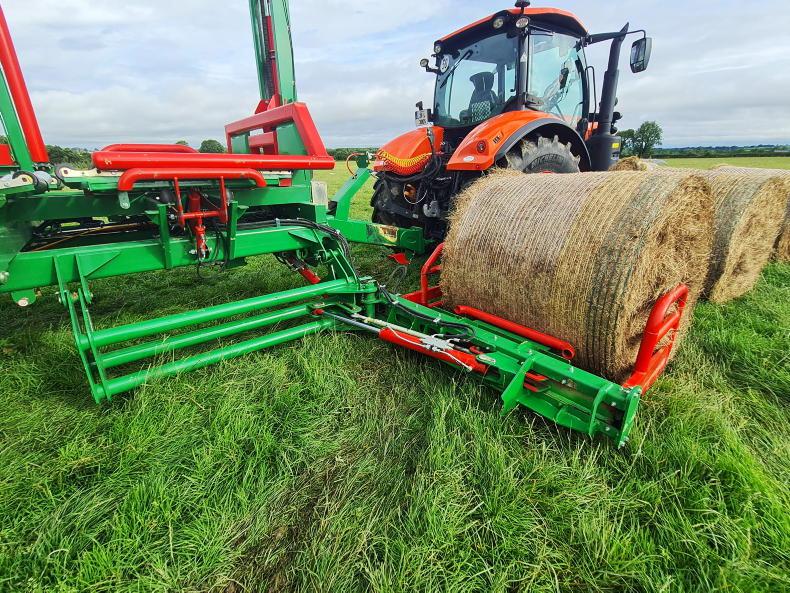
The loading arm clamps the bale and swings round in an arc and the bale is lifted and placed on to the deck of the trailer.
How does it work?
The machine picks up the bales in the same direction as the baler releases them, with the benefit here being that there is no need to cross the field, such is the case with caged round bale chasers.
The operator drives alongside the bale, guiding the loading arm around the bale. Once signalled by the operator through the joystick, the forward-facing cradle with two soft hands will clamp the bale.
A pressure setting in the handling arm, using the on-board controller and joystick, allows the operator to select the correct parameters to suit the bales at hand.
The clamped bale is then automatically lifted by the two flat sides where there is most plastic. The bale swings round in an arc through 90°, where the bale is lifted and placed on to the deck of the trailer.
A kicker table will automatically throw the bale over to the adjacent side of the trailer. The original bale-loading process is repeated and a second bale is loaded.
Once the bottom two bales are loaded, they are moved upwards via a mast to allow the process to be repeated and two more bales to be loaded underneath. The concept of the mast was based on the same principals of a forklift.
Once the first four bales have been loaded, the unit will automatically transfer them to position three on the body, where they are clamped in place using the top grippers.
Proximity sensors will pick up the bales’ location on the unit. This happens while the process of loading another four bales begins.
The sides of the chaser are hydraulically widened to prevent the bales ripping as they are pushed down the chassis.
Depending on the crop and density of the bale, the operator can choose from 11 different positions. This 300mm range of movement can be adjusted in 20mm increments, all of which is controlled through the terminal in the cab. 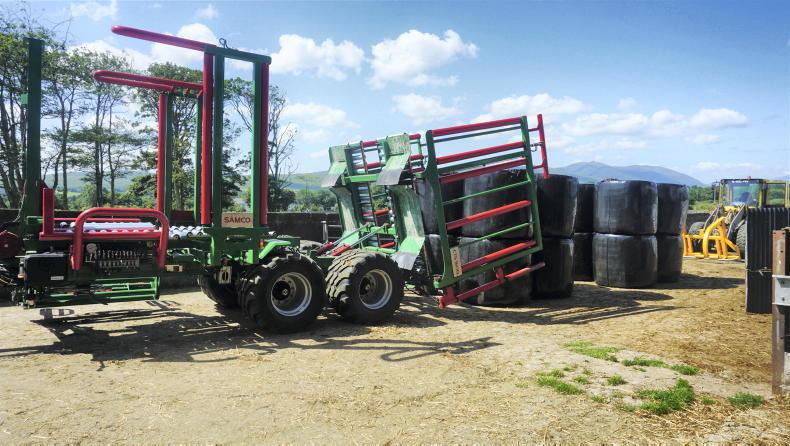
The unloading system then tips the rear eight bales on their ends, two high.
Unloading
When it comes to unloading, the first step is to drop the loading arm. The unloading system then tips the rear eight bales on their ends, two high.
By extending the sides, the bales are released and the rear of the body is brought back down. Once folded down, the front eight bales are then pushed to the rear of the chassis.
Boundary lines can be set on the reversing camera to help the operator pinpoint where the bales will be tipped. This system means the footprint to unload the bales is significantly reduced.
The bales being stacked two high takes away the requirement for a tractor or loader to be present in the yard. 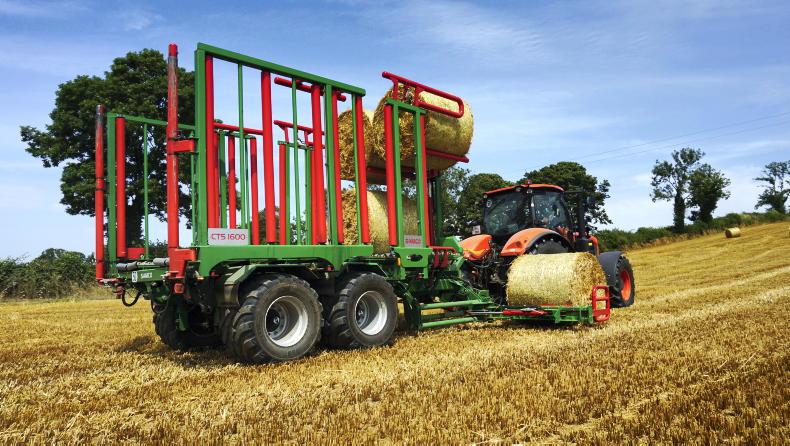
"The fastest loading time I’ve achieved has been seven minutes and 50 seconds. The average run of the mill would be around nine minutes and 10 seconds”, said Cathal Nolan.
Controls and tractor requirements
All controls are carried out through a dedicated joystick and control terminal in the cab. The process can be operated manually or automatically. It has the added benefit of being capable of being operated manually should a sensor ever give trouble.
This is the first of the prototype units to be fitted with the automatic function. Although this brings significant added cost, Samco trials demonstrated at least a 50% increased loading speed over the original prototype.
The Limerick manufacturer equipped the prototype unit to a 170hp flagship Kubota M172, which weighs in at around 7t.
The manufacturer would recommend a similar-sized tractor, although a well-weighted 150hp tractor would also manage.
Hydraulic requirement is 100l/min with load sensing, which generally won’t be an issue for a tractor of this type.
In terms of machine coupling, the chaser requires a flow-and-return connection alongside a load-sensing connection. No spool valves are required. 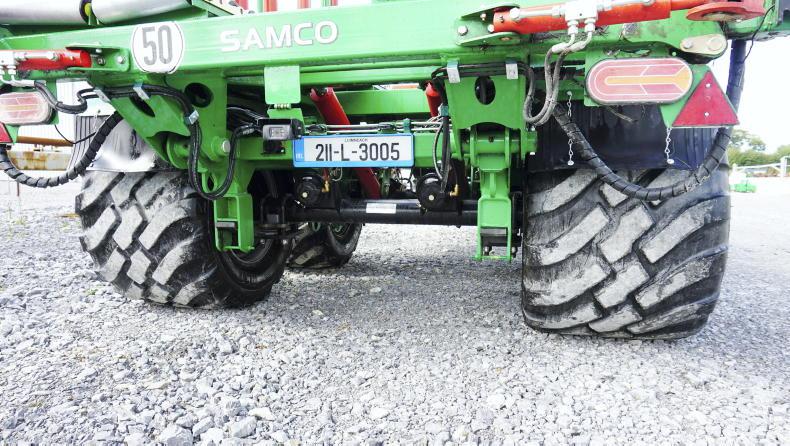
Samco is using high-speed commercial-rated axles on a heavy single-leaf spring coupled with 710/40-R22.5 BKT tyres.
Output
Similar to any bale chaser or machine, the output capacity of the CTS 1600 is hugely variable, depending on factors such as how many bales/ac are in the field, how big or small the fields are, the length of the draw, how manoeuvrable the yard is and, most of all, the skillset and experience of the driver.
Cathal Nolan, a third-year student in Tralee IT, was lucky enough to get the summer job of piloting the prototype unit.
He explained: “We have probably put over 3,000 bales through the machine so far. The fastest loading time I’ve achieved has been seven minutes and 50 seconds.
“The average run of the mill would be around nine minutes and 10 seconds. It generally takes about two minutes to unload then.” 
All controls are carried out through a dedicated joystick and control terminal in the cab.
Running gear
Samco is sourcing the high-speed commercial-rated axles from Distag QCS in Carlow. With load-sensing air brakes, this bogie axle is suspended on a heavy single-leaf spring.
The trailer is not fitted with a steering axle and due to the compactness of the unit (approximately 17ft long), Samco doesn’t currently feel it’s necessary. The chaser also features a sprung drawbar.
Meanwhile, the unit is shod on 710/40-R22.5 BKT tyres, which are sourced from Agri Gear in Cavan. Samco said it will fit other sizes on request.
Nelson Hi Power supplied the Danfoss electro-hydraulic system for the build.
In line with trailer regulations (for 40km/h tractors), the chaser is fitted with a parking brake which couples as a breakaway device, attached to the tractor via a wire rope.
For use at high speed, the air brakes will also operate as a breakaway system in the event of decoupling. The machine comes as standard with LED tail and sidelights.
Any machine that features a lot of moving parts will inevitably be fitted with a lot of grease points.
In fact, there are around 35 grease nipples on this unit.
Although not fitted to this machine, Samco is looking at grouping grease points into central blocks. 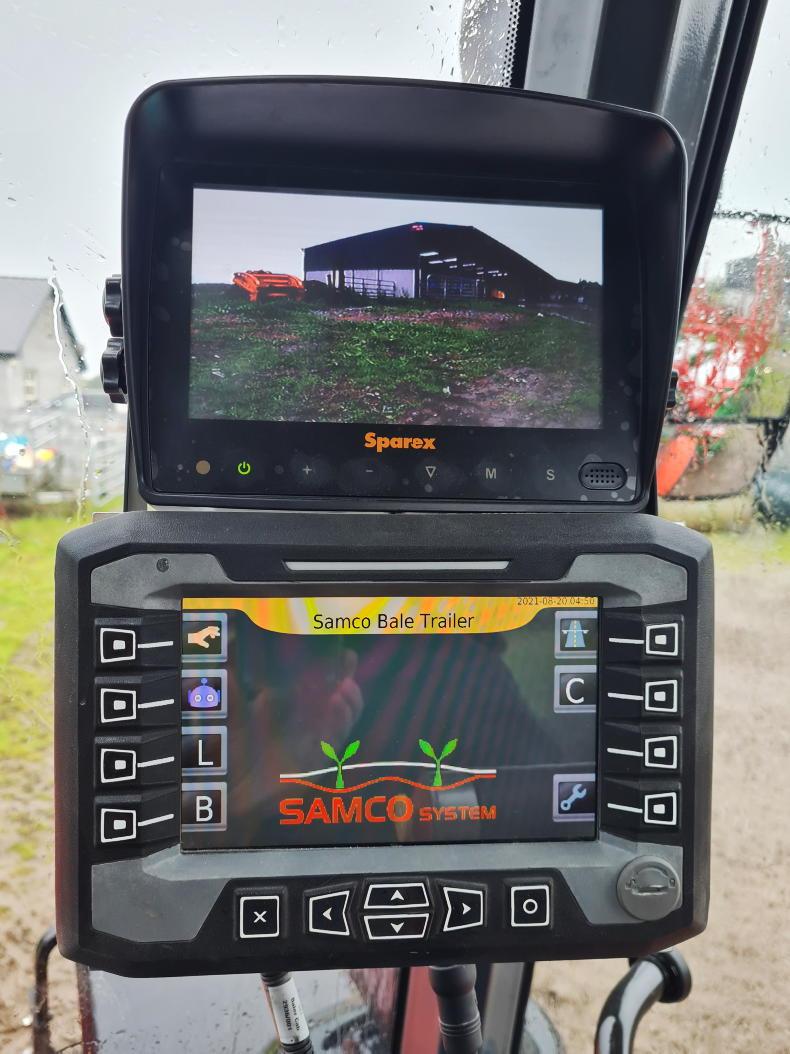
Control terminal and camera monitor.
First impressions
From a design point of view, the CTS 1600 is clearly well built. Bearing in mind that it is still in the prototype stages, it appears to only require minimal tweaking for it to be ready to market.
Despite initially coming across as being perhaps over-engineered or complicating a simple task, the advantages and speed at which bales can be safely moved became much more apparent.
It is evident that a skilled operator is key to the success of the machine. The driver of the chaser needs to have the same skillset as the baler driver, if not better, to get the best efficiency from the machine.
Boundary lines can be set on the reversing camera to help the operator pinpoint where the bales will be tipped.
What’s next?
Samco has now almost completed its summer demonstration tour. The machine on tour was the first prototype built at the firm’s Limerick base, with a number of slight tweaks and modifications set to appear in the finished version.
It is understood the manufacturer is intending to build at least five to 10 units ahead of the 2022 season, all being 16-bale machines.
Once on the marketplace, Samco is considering following up on requests to offer the design in several other sizes with varying bale carrying capacities.
To date, the manufacturer has had interest worldwide, including from America, South Africa and the Nordic countries.
In terms of pricing, it’s early days and nothing is near confirmed, but it’s understood the machine will come in at somewhere between €65,000 and €70,000 plus VAT. The machine will be officially launched this spring. 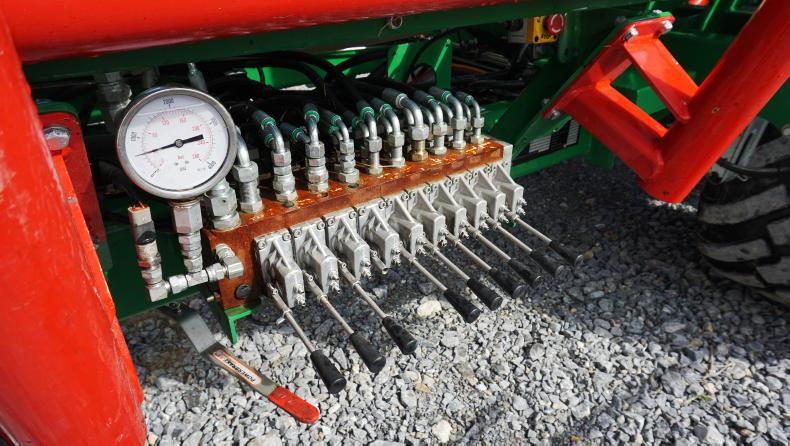
Machine spec:
Model: CTS 1600 (16 bales).Axle: high-speed commercial axle.Unladen weight: 7,400kg.Max laden weight: 27,000kg.Tyres: 710/40-R22.5 BKT.Expected price range: €65,000-€70,000 plus VAT.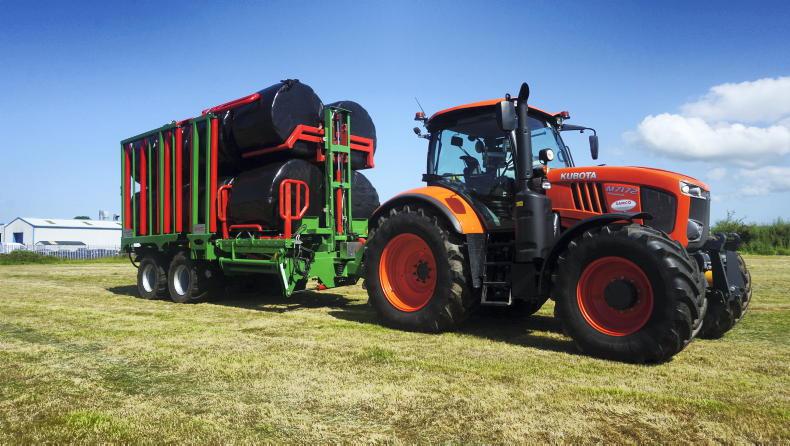
Bringing in bales can be a painstaking task, especially if gathering them one by one. In recent years, quite a few agricultural contractors have expanded their businesses by offering this service to farmers.
This in turn has created opportunities for engineering firms to design and manufacture equipment to streamline the job.
Looking at existing round bale chaser options on the market, the Irish contingent is certainly leading the way.
Keltec and Wilson have been offering a machine for a number of years now, while Malone Farm Machinery has also unveiled its design, which is expected to hit the market inside the next two years.
Meanwhile, Samco Agricultural Engineering (featured) is currently embarking on a demonstration tour around the country, with the Limerick firm hoping its current prototype will be commercially available ahead of the 2022 season.
With a carrying capacity of 16 bales, the trailer is fully automated for the loading and transport of round bales.
The design
Samco has teamed up with Kilkenny engineer and farmer Tom Carrigan on the CTS (collect, transport and stack) bale chaser. This round bale chaser design was the brainchild of Tom, who first drew up plans over eight years ago.
Since then, he has built two bale chasers of his own, the latter of which was quite similar to the prototype featured in this article.
Samco has been working with Tom on the machine for two years now. The machine we visited is the third of such a design built to date and the first officially built by Samco.
With a carrying capacity of 16 bales, the trailer is fully automated for the loading and transport of round bales. 
The loading arm clamps the bale and swings round in an arc and the bale is lifted and placed on to the deck of the trailer.
How does it work?
The machine picks up the bales in the same direction as the baler releases them, with the benefit here being that there is no need to cross the field, such is the case with caged round bale chasers.
The operator drives alongside the bale, guiding the loading arm around the bale. Once signalled by the operator through the joystick, the forward-facing cradle with two soft hands will clamp the bale.
A pressure setting in the handling arm, using the on-board controller and joystick, allows the operator to select the correct parameters to suit the bales at hand.
The clamped bale is then automatically lifted by the two flat sides where there is most plastic. The bale swings round in an arc through 90°, where the bale is lifted and placed on to the deck of the trailer.
A kicker table will automatically throw the bale over to the adjacent side of the trailer. The original bale-loading process is repeated and a second bale is loaded.
Once the bottom two bales are loaded, they are moved upwards via a mast to allow the process to be repeated and two more bales to be loaded underneath. The concept of the mast was based on the same principals of a forklift.
Once the first four bales have been loaded, the unit will automatically transfer them to position three on the body, where they are clamped in place using the top grippers.
Proximity sensors will pick up the bales’ location on the unit. This happens while the process of loading another four bales begins.
The sides of the chaser are hydraulically widened to prevent the bales ripping as they are pushed down the chassis.
Depending on the crop and density of the bale, the operator can choose from 11 different positions. This 300mm range of movement can be adjusted in 20mm increments, all of which is controlled through the terminal in the cab. 
The unloading system then tips the rear eight bales on their ends, two high.
Unloading
When it comes to unloading, the first step is to drop the loading arm. The unloading system then tips the rear eight bales on their ends, two high.
By extending the sides, the bales are released and the rear of the body is brought back down. Once folded down, the front eight bales are then pushed to the rear of the chassis.
Boundary lines can be set on the reversing camera to help the operator pinpoint where the bales will be tipped. This system means the footprint to unload the bales is significantly reduced.
The bales being stacked two high takes away the requirement for a tractor or loader to be present in the yard. 
"The fastest loading time I’ve achieved has been seven minutes and 50 seconds. The average run of the mill would be around nine minutes and 10 seconds”, said Cathal Nolan.
Controls and tractor requirements
All controls are carried out through a dedicated joystick and control terminal in the cab. The process can be operated manually or automatically. It has the added benefit of being capable of being operated manually should a sensor ever give trouble.
This is the first of the prototype units to be fitted with the automatic function. Although this brings significant added cost, Samco trials demonstrated at least a 50% increased loading speed over the original prototype.
The Limerick manufacturer equipped the prototype unit to a 170hp flagship Kubota M172, which weighs in at around 7t.
The manufacturer would recommend a similar-sized tractor, although a well-weighted 150hp tractor would also manage.
Hydraulic requirement is 100l/min with load sensing, which generally won’t be an issue for a tractor of this type.
In terms of machine coupling, the chaser requires a flow-and-return connection alongside a load-sensing connection. No spool valves are required. 
Samco is using high-speed commercial-rated axles on a heavy single-leaf spring coupled with 710/40-R22.5 BKT tyres.
Output
Similar to any bale chaser or machine, the output capacity of the CTS 1600 is hugely variable, depending on factors such as how many bales/ac are in the field, how big or small the fields are, the length of the draw, how manoeuvrable the yard is and, most of all, the skillset and experience of the driver.
Cathal Nolan, a third-year student in Tralee IT, was lucky enough to get the summer job of piloting the prototype unit.
He explained: “We have probably put over 3,000 bales through the machine so far. The fastest loading time I’ve achieved has been seven minutes and 50 seconds.
“The average run of the mill would be around nine minutes and 10 seconds. It generally takes about two minutes to unload then.” 
All controls are carried out through a dedicated joystick and control terminal in the cab.
Running gear
Samco is sourcing the high-speed commercial-rated axles from Distag QCS in Carlow. With load-sensing air brakes, this bogie axle is suspended on a heavy single-leaf spring.
The trailer is not fitted with a steering axle and due to the compactness of the unit (approximately 17ft long), Samco doesn’t currently feel it’s necessary. The chaser also features a sprung drawbar.
Meanwhile, the unit is shod on 710/40-R22.5 BKT tyres, which are sourced from Agri Gear in Cavan. Samco said it will fit other sizes on request.
Nelson Hi Power supplied the Danfoss electro-hydraulic system for the build.
In line with trailer regulations (for 40km/h tractors), the chaser is fitted with a parking brake which couples as a breakaway device, attached to the tractor via a wire rope.
For use at high speed, the air brakes will also operate as a breakaway system in the event of decoupling. The machine comes as standard with LED tail and sidelights.
Any machine that features a lot of moving parts will inevitably be fitted with a lot of grease points.
In fact, there are around 35 grease nipples on this unit.
Although not fitted to this machine, Samco is looking at grouping grease points into central blocks. 
Control terminal and camera monitor.
First impressions
From a design point of view, the CTS 1600 is clearly well built. Bearing in mind that it is still in the prototype stages, it appears to only require minimal tweaking for it to be ready to market.
Despite initially coming across as being perhaps over-engineered or complicating a simple task, the advantages and speed at which bales can be safely moved became much more apparent.
It is evident that a skilled operator is key to the success of the machine. The driver of the chaser needs to have the same skillset as the baler driver, if not better, to get the best efficiency from the machine.
Boundary lines can be set on the reversing camera to help the operator pinpoint where the bales will be tipped.
What’s next?
Samco has now almost completed its summer demonstration tour. The machine on tour was the first prototype built at the firm’s Limerick base, with a number of slight tweaks and modifications set to appear in the finished version.
It is understood the manufacturer is intending to build at least five to 10 units ahead of the 2022 season, all being 16-bale machines.
Once on the marketplace, Samco is considering following up on requests to offer the design in several other sizes with varying bale carrying capacities.
To date, the manufacturer has had interest worldwide, including from America, South Africa and the Nordic countries.
In terms of pricing, it’s early days and nothing is near confirmed, but it’s understood the machine will come in at somewhere between €65,000 and €70,000 plus VAT. The machine will be officially launched this spring. 
Machine spec:
Model: CTS 1600 (16 bales).Axle: high-speed commercial axle.Unladen weight: 7,400kg.Max laden weight: 27,000kg.Tyres: 710/40-R22.5 BKT.Expected price range: €65,000-€70,000 plus VAT.
















 This is a subscriber-only article
This is a subscriber-only article









SHARING OPTIONS: